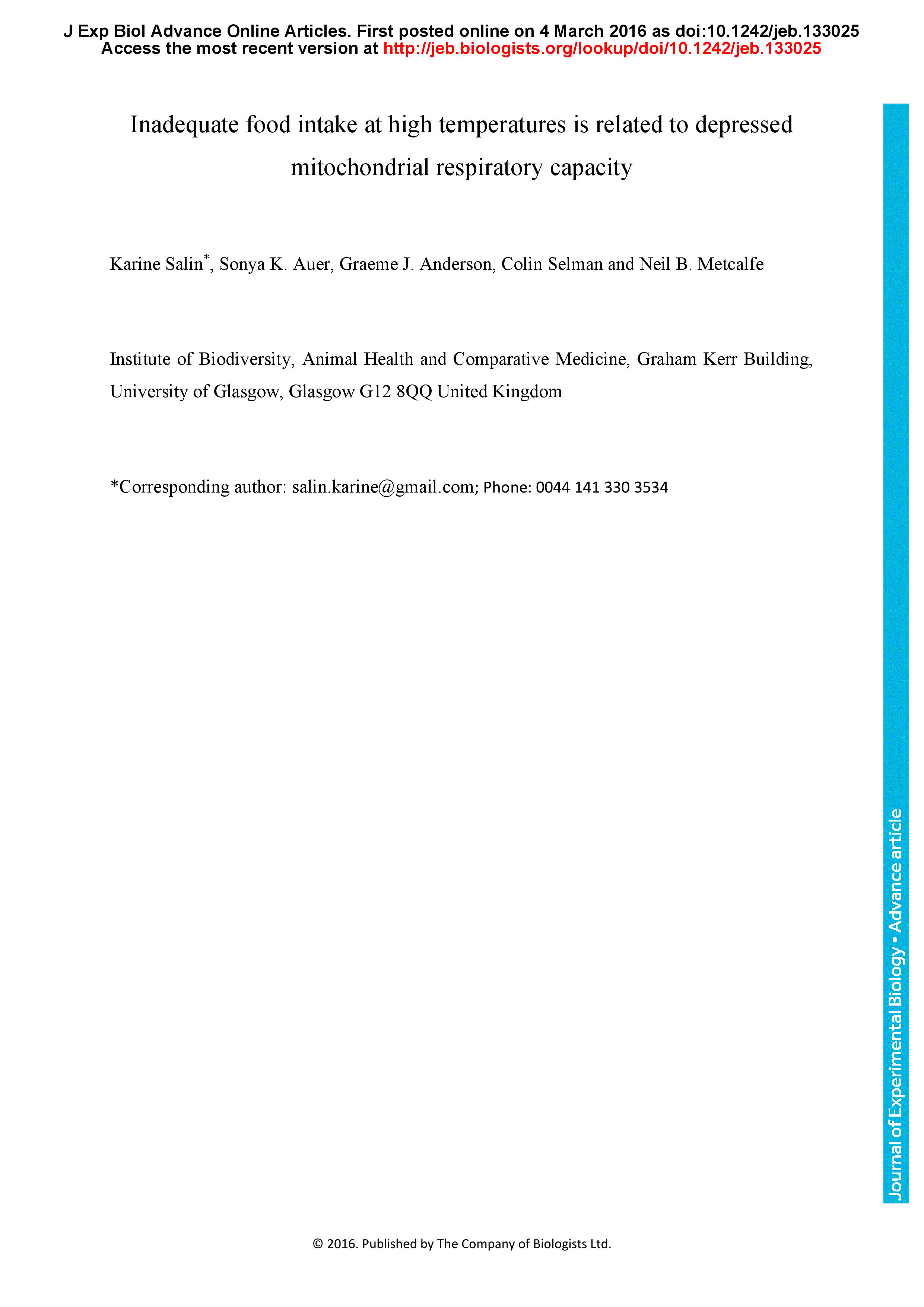Animals, especially ectotherms, are highly sensitive to the temperature of their surrounding environment. Extremely high temperature, for example, induces a decline of average performance of conspecifics within a population, but individual heterogeneity in the ability to cope with elevating temperatures has rarely been studied. In this study, we examined inter-individual variation in feeding ability and consequent growth rate of juvenile brown trout Salmo trutta acclimated to a high temperature (19°C), and investigated the relationship between these metrics of whole-animal performances and among-individual variation in mitochondrial respiration capacity. Food was provided ad libitum yet intake varied ten-fold amongst individuals, resulting in some fish losing weight whilst others continued to grow. Almost half of the variation in food intake was related to variability in mitochondrial capacity: low intake (and hence growth failure) was associated with high leak respiration rates within liver and muscle mitochondria, and a lower coupling of muscle mitochondria. These observations, combined with the inability of fish with low food consumption to increase their intake despite ad libitum food levels, suggest a possible insufficient capacity of the mitochondria for maintaining ATP homeostasis. Individual variation in thermal performance is likely to confer variation in the upper limit of an organism's thermal niche and in turn affect the structure of wild populations in warming environments.
Inadequate food intake at high temperatures is related to depressed mitochondrial respiratory capacity
Currently Viewing Accepted Manuscript - Newer Version Available
Karine Salin, Sonya K. Auer, Graeme J. Anderson, Colin Selman, Neil B. Metcalfe; Inadequate food intake at high temperatures is related to depressed mitochondrial respiratory capacity. J Exp Biol 2016; jeb.133025. doi: https://doi.org/10.1242/jeb.133025
Download citation file:
Advertisement
2023 JEB Outstanding Paper Prize shortlist and winner

The JEB Editors are delighted to announce the shortlisted authors for the 2023 JEB Outstanding Paper Prize. Read the winning paper - Tiny spies: mosquito antennae are sensitive sensors for eavesdropping on frog calls - by Hoover Pantoja-Sanchez and Brian Leavell from Ximena Bernal's lab at Purdue University, USA.
JEB Science Communication Workshop for ECRs

If you’re an early-career researcher interested in science communication and are attending the SEB Annual Conference in Prague this summer, come a day early and join the JEB Editors at a sci comm workshop to learn the key writing skills needed to promote your research to a broad audience beyond your peers (1 July at 14.30-17.30). Places are limited to 24 attendees, and applicants should apply through the SEB registration page by 30 April 2024.
Bridging the gap between controlled conditions and natural habitats in understanding behaviour

Novel technologies enable behavioural experiments with non-model species, in naturalistic habitats and with underexplored behaviours. In their Commentary, Scholz and colleagues discuss how to obtain a deeper understanding of the natural ecology and lifestyle of study animals.
Beluga metabolic measures could help save species

To help save animals from extinction, it’s important to understand what each species needs to survive. This led Jason John et al. to measure the metabolic rates of captive belugas to develop a ‘fish calculator’ showing that the whales need to eat ~23 salmon per day.
ECR Workshop on Positive Peer Review

Are you an ECR looking for tips on how to write concise, astute and useful manuscript reviews? If so, join the JEB Editors at a 2-hour JEB-sponsored Workshop on Positive Peer Review at the Canadian Society of Zoologists annual meeting in Moncton on 9 May 2024 at 13.00-15.00. There are 25 spaces for ECRs and selection is first come, first serve. To sign up, check the ECR Workshop box when you register for the CSZ meeting.



